
A Natural Progression
by Nicole Hadad
August 2nd, 2015
Long Island’s East End has long been as famous for its artists-in-residence as for the remarkable quality of its light. Steve Miller, a multimedia artist, has been spending time there since the 1980s, when he found the truly unique, light-saturated weekend getaway that he calls home and studio: a large, steel-and-concrete building-turned-artist’s-oasis with a history as rich as its surroundings. The time Miller spends there is a far cry from the mad, mad pace of New York City, where, among his other ventures, he is a founding partner of the ARTLOCAL app.
Tucked away on a side street in Sagaponack and situated parallel to the railroad tracks, Miller’s building, which encompasses nearly 5,000 square feet of living space, has had several lives. Originally built as a commuter rail station around the turn of the 20th century, it had its second incarnation as a Grady’s potato barn in the 1940s. A decline of the area’s potato industry led to its third reinvention in the 1970s, when artists Neil Williams and Frank Stella renovated it into a working studio. When Stella eventually tired of the place, around 1980, Miller began renting it. He finally purchased it six years later.
Much of the building’s past is still visible today. The entrance to the home is the former potato factory’s loading ramp. Miller has kept the original wood floorboards, nearly two inches thick, throughout. An old potato pallet serves as the living room coffee table.
The main focus of the house is Miller’s expansive, loft-like working studio, where his fine art surfboards featuring silk-screened digital X-rays of flora, fauna, piranhas, snakes and more from Brazil’s Amazon Basin steal the show. Skylights in the studio’s 14-foot ceilings (at peak) flood the space with natural light.
Like so many artists, Miller was initially content to leave things be, describing his design style as “modernist neglect.” Successive romantic relationships motivated him to make his home more livable. First came the kitchen. Out went his hotplate and a slop tub/sink left by Stella. In came a fully functional domestic workspace that Miller painted a dark shade of pewter to create a backdrop for art.
The kitchen, living room, and studio are basically one room—a classic modern open plan. Miller put up a short, screen-like wall between the studio and the living area to create a sense of separation and provide a bit more intimacy for social gatherings and dinner guests. An adventurous host, he once held a dinner party with a meal entirely of foraged ingredients and venison locally shot with a bow.
To the right of the kitchen, an easily missed door leads to Miller’s incredibly large bedroom. Although it took the artist many years and a new romance before tackling this section of the house, he brought in architect Carlos Brillembourg to implement a total gut renovation. A former darkroom became a de facto gallery behind the bed—a floating wall separates the two areas—and the bathroom was done to the nines with Dornbracht fixtures, a new skylight, a marble counter with twin sinks, and a steam shower and room. As Miller cheerfully puts it, “Although the relationships didn’t last, the renovations did.”
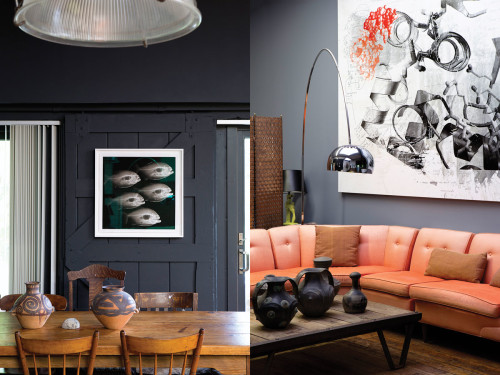 In the kitchen, Miller painted an old barn door in a rich, steely pewter to form a backdrop for his artwork. A digital X-ray of a school of piranhas from the Amazon Basin printed with carbon pigment onto Hahnemuhle paper hangs there now. Right: Miller kept the living room sofa he inherited with the space and turned an old potato pallet into a coffee table. Above the sofa hangs Immediately Identifiable, a painting by Miller incorporating the Nobel Prize-winning biochemist Rod MacKinnon’s models of human proteins and notes for constructing them. Miller has consistently worked at the intersection of art and science. “I like looking at the world through the framework of science and technology,” he says.
In the kitchen, Miller painted an old barn door in a rich, steely pewter to form a backdrop for his artwork. A digital X-ray of a school of piranhas from the Amazon Basin printed with carbon pigment onto Hahnemuhle paper hangs there now. Right: Miller kept the living room sofa he inherited with the space and turned an old potato pallet into a coffee table. Above the sofa hangs Immediately Identifiable, a painting by Miller incorporating the Nobel Prize-winning biochemist Rod MacKinnon’s models of human proteins and notes for constructing them. Miller has consistently worked at the intersection of art and science. “I like looking at the world through the framework of science and technology,” he says.
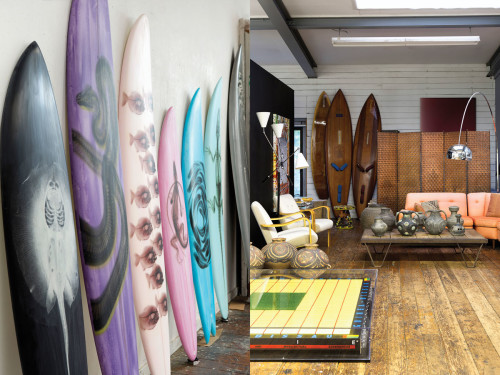 Left: In part of his Health of the Planet series, Miller silk-screened digital X-rays of piranhas, stingrays, snakes, iguanas, fish, and alligators from the Amazon onto his fine art surfboards. Right: Miller slid his Central Orchid in front of an unsightly radiator. Although it nicely offsets the John Chamberlain sculpture on the wall, Miller insists, “Don’t give me credit for any conscious decisions, there is always an organic energy of movement. There is no master plan.”
Left: In part of his Health of the Planet series, Miller silk-screened digital X-rays of piranhas, stingrays, snakes, iguanas, fish, and alligators from the Amazon onto his fine art surfboards. Right: Miller slid his Central Orchid in front of an unsightly radiator. Although it nicely offsets the John Chamberlain sculpture on the wall, Miller insists, “Don’t give me credit for any conscious decisions, there is always an organic energy of movement. There is no master plan.”
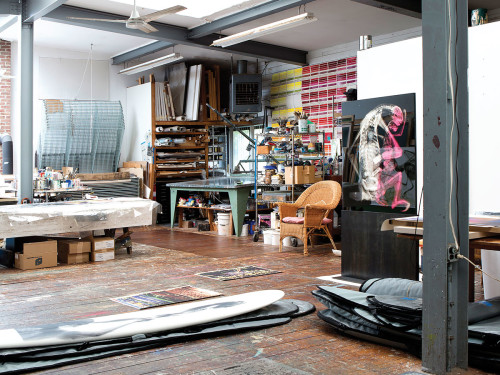 Miller’s studio
Miller’s studio
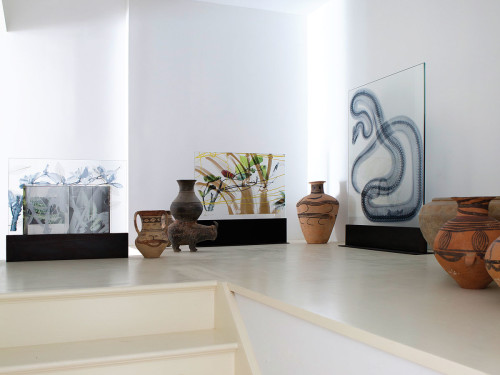 Architect Carlos Brillembourg tore down walls and painted surfaces in what was once a dreary darkroom, creating a de facto gallery space.
Architect Carlos Brillembourg tore down walls and painted surfaces in what was once a dreary darkroom, creating a de facto gallery space.
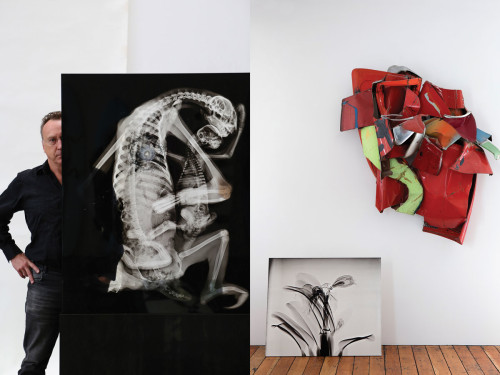 Left: In Sloth Pieta, Miller X-rayed a Brazilian sloth—a species suffering due to air pollution and loss of habitat—embracing her offspring. To not-so-subtly illustrate the fragility of biodiversity and the impact we have on the planet, Miller had a friend shoot a bullet right at the sloth’s heart, cracking the glass laminated X-ray. Right: Neolithic pottery Miller picked up during a stint teaching at a university in Hong Kong adorns the coffee table and floor. Miller traded a painting for the woven copper screen next to the windsurfers that “weighs a ton”; it also serves to hide a guest bed. On the left is a work by Ashley Bickerton. “It takes up a lot of floor space. It’s inconvenient, and it’s something you can’t ignore—and when you can’t ignore something, it’s very captivating,” says Miller.
Left: In Sloth Pieta, Miller X-rayed a Brazilian sloth—a species suffering due to air pollution and loss of habitat—embracing her offspring. To not-so-subtly illustrate the fragility of biodiversity and the impact we have on the planet, Miller had a friend shoot a bullet right at the sloth’s heart, cracking the glass laminated X-ray. Right: Neolithic pottery Miller picked up during a stint teaching at a university in Hong Kong adorns the coffee table and floor. Miller traded a painting for the woven copper screen next to the windsurfers that “weighs a ton”; it also serves to hide a guest bed. On the left is a work by Ashley Bickerton. “It takes up a lot of floor space. It’s inconvenient, and it’s something you can’t ignore—and when you can’t ignore something, it’s very captivating,” says Miller.
